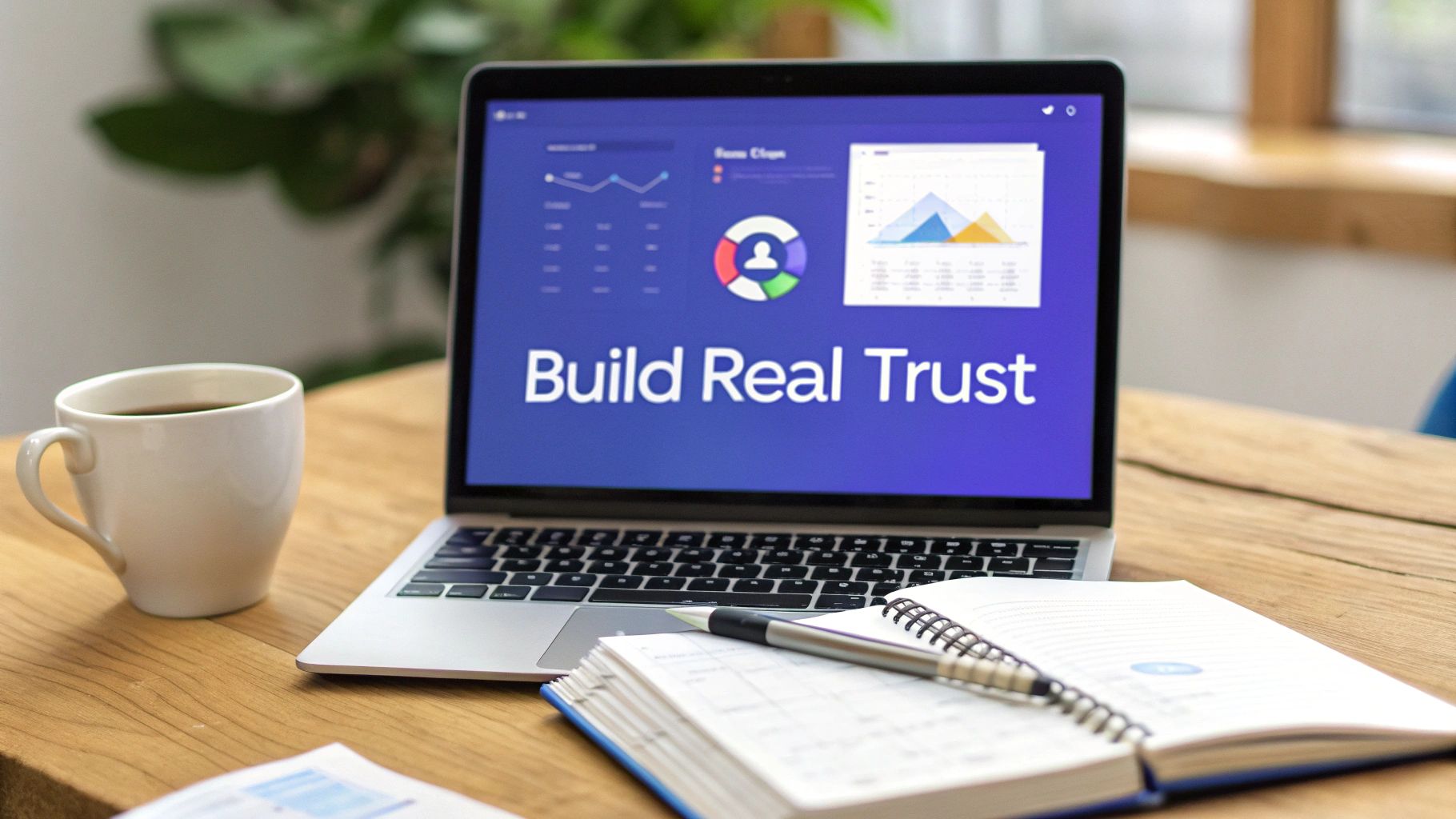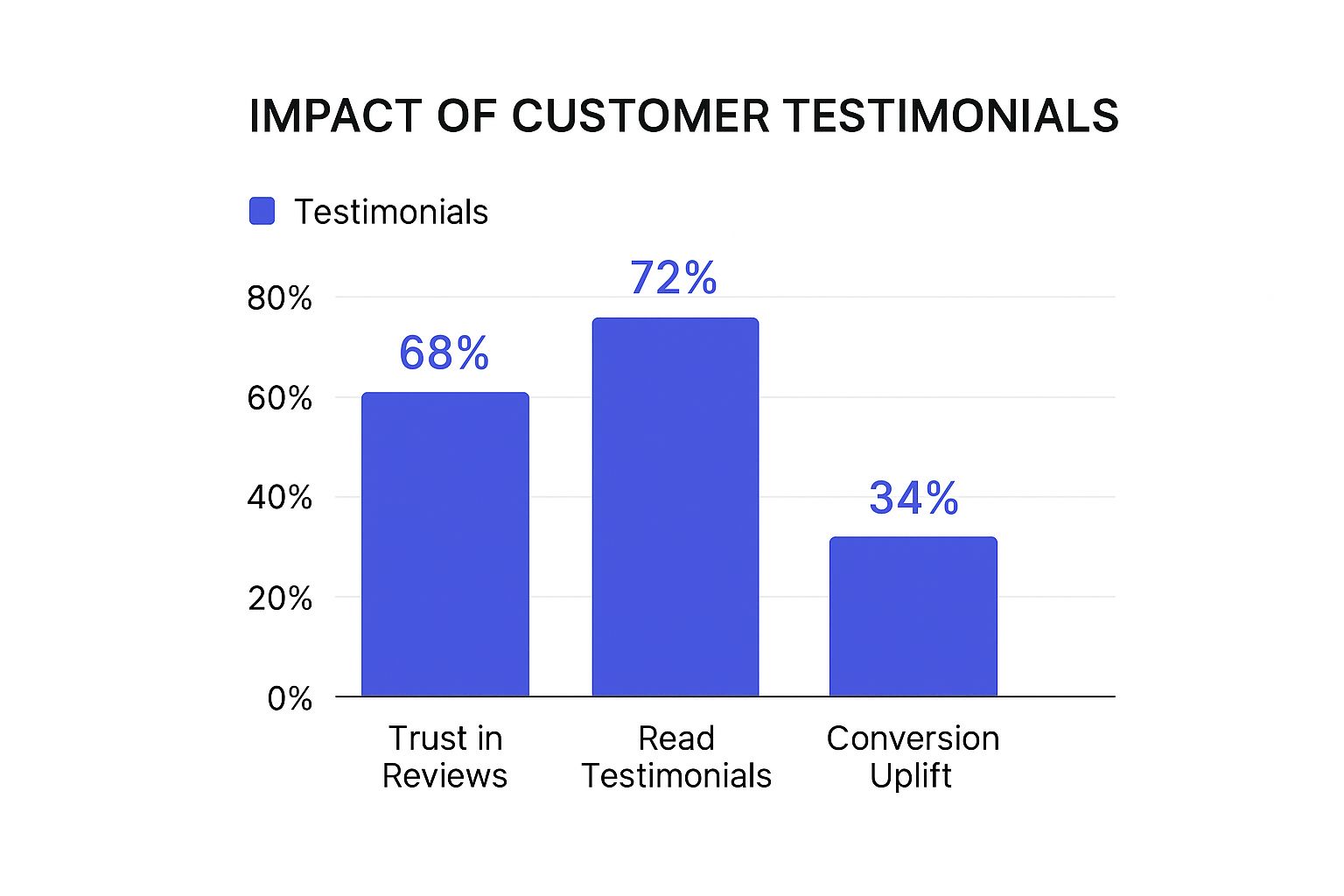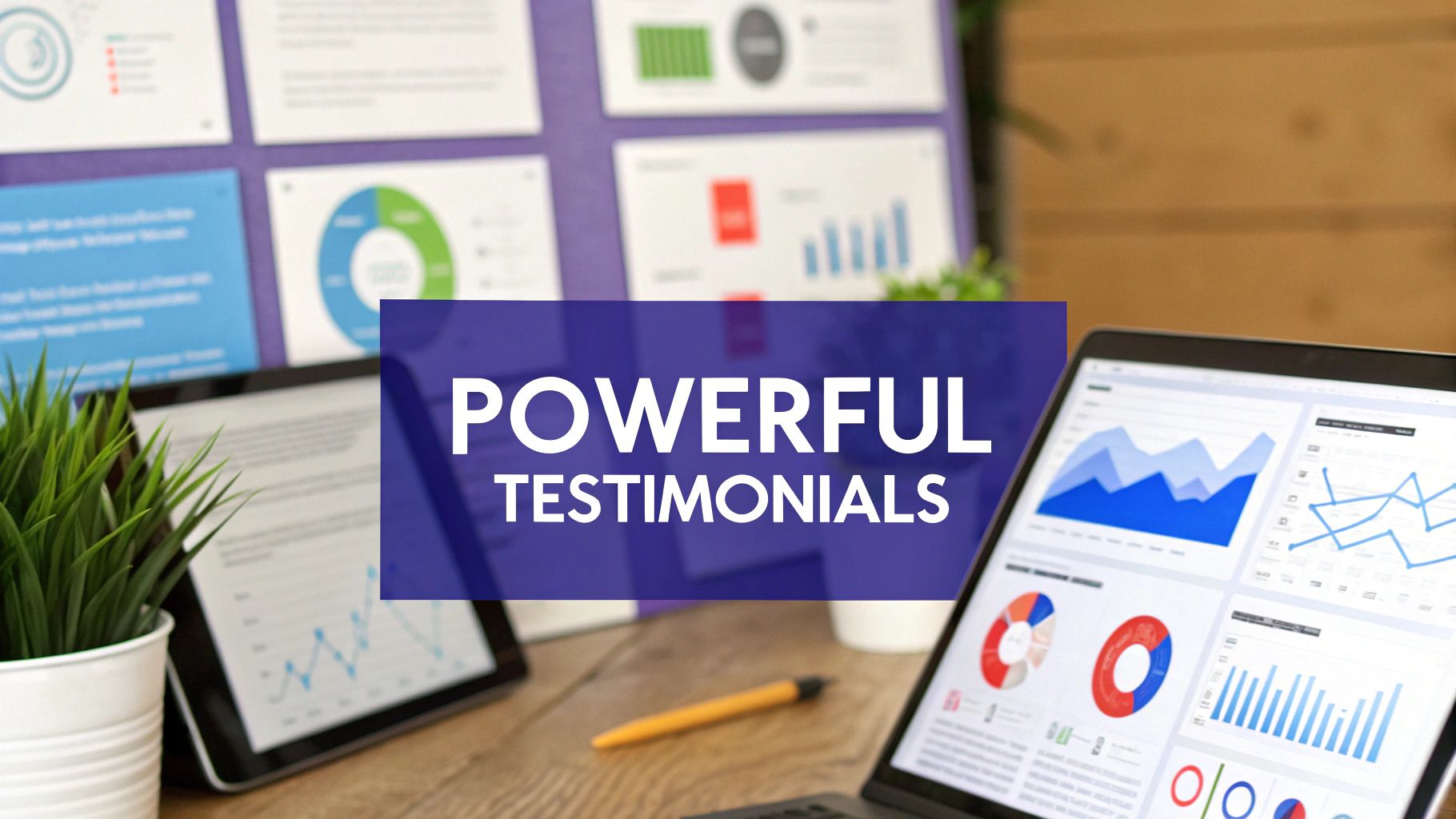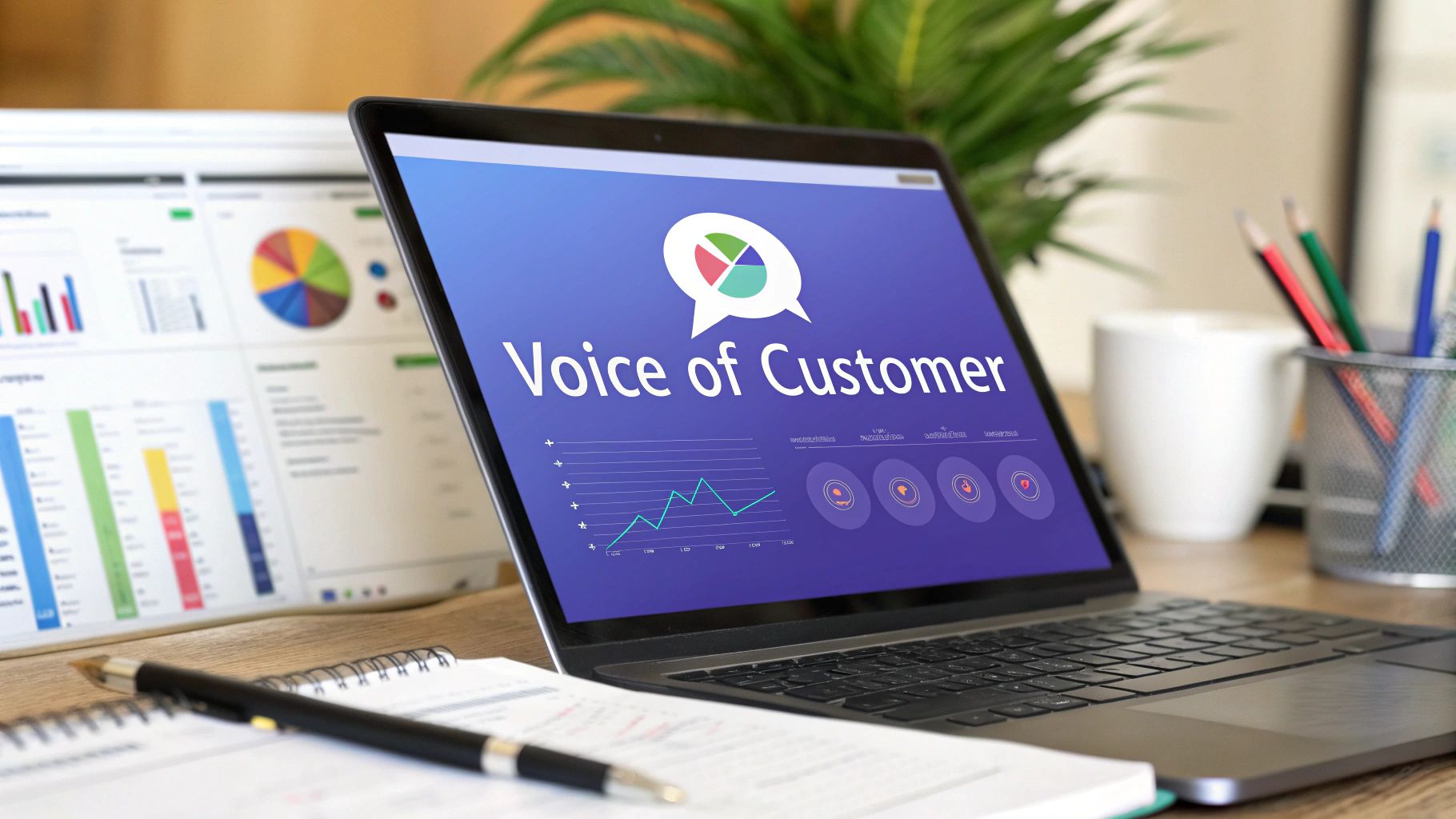How to Write Testimonials That Build Real Trust
Learn how to write testimonials that build authentic customer trust and drive sales. Get proven strategies and real-world examples to master social proof.

A great testimonial is simply a story with a beginning (the problem), a middle (your product as the hero), and a happy ending (the awesome result). This simple problem-solution-result formula is the secret to turning a bland customer comment into a powerful story that actually convinces people to buy.
Why Authentic Testimonials Are Your Secret Sales Weapon
Before we get into the nitty-gritty of writing killer testimonials, let's talk about why they work so well. In the SaaS and B2B world, buyers are tired of flashy ads and marketing jargon. They're skeptical. So, who do they trust? Their peers.
This is social proof in its purest form. A real, honest-to-goodness testimonial acts as a direct line of trust from one customer to another. It’s not just a quote you slap on your homepage; it’s proof that you deliver on your promises, straight from someone who’s already been there.
The Psychology of Peer-Driven Decisions
Think about the last time you were about to make a big purchase. Did you just take the company's word for it? Probably not. You likely hunted for reviews, asked for opinions, or dug up some case studies. Your prospects are doing the exact same thing.
They're looking for stories from customers they can relate to. These stories are incredibly persuasive because they answer the big questions swirling in a prospect's head before they even hop on a sales call:
- Can this thing actually solve my specific problem?
- Are other people in my industry using it and winning?
- What kind of results can I really expect?
A solid testimonial basically becomes a 24/7 salesperson, building your credibility while you sleep. The whole world of user-generated content benefits is built on this foundation of trust, and testimonials are a cornerstone of that strategy.
The Impact of Strategic vs Generic Testimonials
Not all testimonials are created equal. A generic "They're great!" quote does very little, but a strategic, story-driven testimonial can be a game-changer. The difference is stark.
AttributeGeneric TestimonialStrategic TestimonialSpecificityVague praise like "Great product!"Mentions specific features and outcomes.RelatabilityNo context about the customer or their role.Identifies the customer's industry, role, or company size.ProblemDoesn't mention the initial challenge.Clearly outlines the problem they were facing.SolutionFails to connect the product to a solution.Explains how the product specifically solved the problem.ResultLacks any measurable impact.Quantifies the success with numbers or clear benefits.EmotionSounds flat and uninspired.Conveys genuine emotion, like relief or excitement.CredibilityAnonymous or lacks a full name/company.Includes a real name, photo, and company for authenticity.
As you can see, the effort to get a strategic testimonial pays off. It's the difference between a forgettable comment and a memorable story that drives sales.
The Data Doesn't Lie: Trust Drives Conversions
This isn't just a gut feeling; there's hard data to back it up. The connection between customer reviews, the trust they build, and actual sales is crystal clear.

The numbers speak for themselves. A huge majority of customers read and trust what other customers have to say, which directly boosts conversions. Think about it: research shows 72% of customers trust a business more after seeing positive reviews. This is huge, especially when you consider that 92% of B2B buyers read them before making a purchase.
Without that trust, you're fighting an uphill battle.
A great testimonial doesn't just sell a product; it sells confidence. It tells a potential customer, "Someone just like you had this exact problem, and this is how they won." This is the core of modern, trust-based marketing.
Finding and Asking for Powerful Customer Stories

The most compelling testimonials don't just appear out of thin air. You can't just collect them; you have to cultivate them. The real secret is to stop thinking about it as a generic request and start seeing it as a chance to put a spotlight on your customers' wins. It all starts with finding the right people to ask—your happiest, most successful users.
These are the customers who haven't just stuck around but have seen real, measurable results with your platform. They're your power users, your biggest fans, and the ones who truly get the value you offer. The challenge isn't just finding them; it's knowing the perfect moment to reach out.
Identify Your Power Users and Success Stories
Before you even think about what a great testimonial looks like, you have to know who to ask. Your most powerful stories will come from customers who have deeply woven your product into their daily workflow.
Start by digging into your own data for signals of success. For a SaaS company like Surva.ai, these signs are pretty clear:
- High Engagement: Which users are in the app all the time, building surveys and checking their results?
- Feature Adoption: Are there accounts that jumped on a new feature right away and are now using it heavily?
- Positive Support Interactions: Did a customer just have a fantastic experience with your support team where a problem was solved in minutes?
- Expansion Revenue: Have any customers recently upgraded their plan or added more seats to their account?
These folks are your prime candidates. They aren't just satisfied; they're actively succeeding. That makes them the perfect source for a story that shows a tangible return on investment.
So many teams make the mistake of sending out a mass email blast asking for testimonials. It rarely works. You’re much better off focusing your energy on a small group of super successful customers. Your success rate will be higher, and the quality of the feedback will be so much better.
The Art of the Ask: Timing and Approach
Once you've got a list of your champions, timing is everything. You want to make the ask when their positive feelings about your brand are at an all-time high. For instance, triggering a request right after they've successfully launched their first big survey campaign can be incredibly effective.
Your approach should feel personal, never automated. The goal is to make your customer feel special, not like they're just another number in a spreadsheet. Try turning your request into a collaboration. Instead of just asking for a quote, frame it as an opportunity to feature their success story. You’re not just asking for a favor; you're offering them a platform to showcase their own smart decision-making.
For a deeper dive, our guide on how to ask for testimonials gives you specific templates and communication tactics that can turn a simple request into a compelling invitation. This approach doesn't just get you a better testimonial; it builds a stronger relationship and ensures the stories you receive are packed with authentic detail and enthusiasm—the perfect raw material.
Guiding Customers to Provide Great Feedback

If you've ever just asked a customer, “Can you write us a testimonial?” you probably know how that story ends. It’s a vague request that puts all the work on them and usually nets you a generic, unhelpful quote like, "They're great!" or "We love the product." You get some praise, sure, but you don't get a story that actually sells.
There’s a much better way. Instead of asking for a finished testimonial, you guide your customer toward the story you need them to tell. You do this by asking a series of structured, open-ended questions designed to pull out the specific details, emotions, and results that make a testimonial resonate with prospects. This turns a daunting task for your customer into a simple, conversational Q&A.
This is the secret to getting testimonials packed with the kind of authentic detail that builds real trust. Your goal isn't to put words in their mouth, but to prompt them to recall their entire journey with your product—from the initial pain to the final payoff.
The Power of Problem-Focused Questions
Every great story kicks off with a problem. Before a prospect can even care about your solution, they need to see their own struggles reflected in someone else's story. You can draw this out by asking questions that laser-focus on their "before" state.
Instead of a generic prompt, try asking more targeted questions that get to the heart of their original challenge. This helps the customer remember the specific pain points that sent them looking for a solution in the first place.
Here are a few examples that work like a charm:
- What was the single biggest obstacle you faced before you started using Surva.ai?
- Can you describe what your old process for collecting feedback looked like? What frustrated you most about it?
- Were you losing customers or missing opportunities because of this problem?
Notice how these questions don't ask for a testimonial—they ask for a story. The answers you get will become the raw material for that all-important "problem" section of your narrative.
The most powerful testimonials aren't written by your marketing team—they're assembled from the genuine words of your customers. Your job is to ask the right questions that unlock those words. By guiding the conversation, you ensure the final piece is both authentic and strategically effective.
Uncovering the "Aha!" Moment and Quantifiable Results
Once you've established the problem, your follow-up questions should walk them through their decision-making process and, most importantly, the results. You want to understand why they chose you and what specific, measurable impact your product has had.
Vague benefits are forgettable. Hard numbers are persuasive. Your questions should prompt customers to dig for actual data.
Try asking questions like these:
- What made you confident that our platform was the right choice for you?
- Could you share a specific metric that improved after implementing our solution? (e.g., retention rate, response rate, time saved)
- What has been the most significant positive outcome for your team since we started working together?
This kind of structured questioning ensures you gather all the essential components for a powerful story: a relatable problem, a clear solution, and a tangible, quantifiable result.
Turning Raw Feedback into a Compelling Narrative

Once you’ve collected those rich, detailed answers from your customers, the real artistry begins. You’re not just copying and pasting; you're shaping raw feedback into a polished, persuasive story. The goal is to transform those interview notes or survey responses into a narrative that moves a prospect from simple curiosity to real confidence.
This process is about more than just good grammar. It's about structuring the customer's journey in a way that truly resonates with your target audience. Think of yourself as an editor, amplifying the most impactful parts of their story while keeping the authenticity of their voice intact.
Use the Problem-Solution-Result Framework
The most effective testimonials follow a natural story arc that everyone intuitively understands. This isn't about inventing fiction; it's about organizing the customer's real experience into a clear, compelling structure.
This classic framework is your roadmap for writing testimonials that stick:
- The Problem: Kick things off with the specific challenge the customer was facing before they found you. This is the hook that grabs a prospect's attention because it reflects their own pain points.
- The Solution: Clearly explain how your product—in this case, Surva.ai—directly addressed that problem. Focus on the specific features or aspects the customer actually mentioned.
- The Result: Wrap it up with the tangible, measurable outcome. This is the proof that your solution delivers real value, turning a good story into a powerful business case.
Using this structure turns a simple quote into a mini case study, making it far more memorable and persuasive.
Edit for Impact While Keeping It Real
Your role as an editor here is crucial. Raw feedback is often long-winded or unfocused. You need to distill it down to its most powerful essence without losing the customer's unique voice. The key is to add clarity and punch, not a layer of corporate jargon.
A common mistake is over-editing a testimonial until it sounds like it was written by your marketing department. The best testimonials feel real and human. You can clean up grammar and trim rambling sentences, but always keep the core message and original phrasing intact.
This process is a vital part of content marketing. In fact, content marketing revenue is projected to hit over $107 billion by 2026, showing the immense value placed on authentic, persuasive content. With 46% of B2B marketers planning to boost their content budgets, getting testimonials right is a top priority.
For more ideas on structuring your final output, check out our guide on powerful templates for testimonials that can help you get started.
Creating high-quality testimonials is such a priority that 75% of large companies even outsource content writing to ensure the final product connects perfectly with their audience. Ultimately, your goal is to produce a testimonial that is not just believable but also strategically highlights the value propositions that matter most to your future customers.
Amplifying Your Message with Video Testimonials
While powerful written testimonials are the bedrock of your social proof, video takes things to a whole other level. Video testimonials aren’t just about hearing the words; they're about seeing the genuine emotion behind them, forging a much deeper, more human connection with your audience.
This format transforms a customer's success story from a static quote on a page into a living, breathing narrative. The combination of sight and sound makes the experience far more memorable and persuasive than text ever could be.
Why Video Connects So Deeply
There's something incredibly powerful about seeing a real person talk about their success. It creates an authenticity that's tough to replicate in writing. Your prospects can see the excitement in a customer's eyes or hear the relief in their voice as they explain how your product solved a major headache for them. This immediately builds a layer of trust that words alone can't.
And this isn't just a hunch; the data backs it up. Recent research shows that a customer is 2.1 times more likely to remember a testimonial video compared to other marketing content.
Even more telling, a staggering 92% of organizations using video testimonials report a real, tangible increase in conversions. This isn't just for the big players, either—95% of small and medium-sized businesses see similar boosts. You can dig into more of these powerful video testimonial stats to see the full picture.
Just look at the conversion lift when video gets involved.
The data speaks for itself. Swapping out traditional text reviews for video can send conversions soaring by as much as 80%. It’s a clear sign of just how persuasive this format is.
Practical Steps for Great Video Production
Don't worry, you don't need a Hollywood-sized budget to create impactful video testimonials. In fact, sometimes those overly polished, high-production videos can feel a bit staged and less authentic. The real key is to make your customer feel comfortable and to gently guide them in telling their story.
Here are a few practical ways to get it done:
- Self-Recorded Clips: This is the easiest route. Encourage customers to use simple tools they already have, like Loom or just their smartphone. Give them the same guiding questions you’d use for a written testimonial to provide a clear path for them to follow.
- Guided Remote Interviews: Hop on a video call and hit record. This lets you have a natural conversation, ask insightful follow-up questions, and capture those candid, unscripted moments that often make the best soundbites.
- Professional Shoots: If you have a massive success story or a key enterprise client, investing in a professional shoot can be a game-changer. A pro will handle the lighting and sound, making your customer look and feel like a star.
The single most important thing is to make your customer comfortable. Reassure them it’s not about delivering a perfect, flawless performance. It’s simply about sharing their honest experience. Sending the questions over beforehand so they can gather their thoughts is always a great move.
Once you have your footage, a little editing goes a long way. Think of this as learning how to write testimonials, but visually. Don’t go overboard. The goal is just to trim any long pauses or stumbles while making sure the most powerful moments shine. You can also add simple text overlays to highlight key results or metrics they mention.
To get the most mileage out of your videos, it’s worth exploring some broader video marketing strategies for social media to really amplify your engagement and ROI.
Your Top Testimonial Questions, Answered
Once you start digging into testimonials, a few common questions always seem to pop up. I've seen teams get stuck on these details, but getting them right is what separates a good social proof strategy from a great one.
Let's clear up some of the most frequent uncertainties, from handling tricky feedback to sorting out the legal stuff. Think of this as your cheat sheet for managing testimonials like a pro.
What If I Get Negative or Lukewarm Feedback?
First off, don't panic. Not every piece of feedback will be a five-star rave review, and honestly, that’s a good thing. A wall of nothing but perfect praise can feel a little fishy to potential customers.
When you get some less-than-perfect feedback, don't just toss it aside. Treat it as a gift. Your first move should be to reach out to that customer directly. Your goal is to understand what went wrong and, if you can, make it right. I've seen this simple act turn a mildly unhappy user into one of the most loyal advocates a company has.
Beyond that one interaction, look for patterns. A single lukewarm comment could be a one-off, but if you see several people pointing to the same issue, you've just been handed a golden ticket for your product roadmap.
How Long Should a Testimonial Be?
The honest answer? It depends entirely on where you're going to use it. There’s no magic word count. The best approach is to have a few different lengths ready to go for different marketing channels.
- Short & Punchy (15-30 words): These are your go-to snippets for social media, email signatures, or right next to a "Buy Now" button. They need to be quick, powerful, and easy to scan in a second.
- Medium Paragraph (50-100 words): This is the sweet spot for your main testimonials page or featured on your homepage. It gives you just enough room to tell a mini-story—think Problem, Solution, Result—without overwhelming the reader.
- Long-Form or Case Study (300+ words): Save these for your deep-dive blog posts or dedicated case study pages. They’re perfect for prospects at the bottom of the funnel who are doing their final comparisons and need all the juicy details to build a business case.
Where Should I Place Testimonials on My Website?
Strategic placement is everything. Don’t just hide them away on a single "Reviews" page that no one ever visits. You need to sprinkle them throughout your website at the exact moments a potential customer might be second-guessing their decision.
Your best testimonials should appear wherever a prospect might feel a flicker of doubt. Use them to answer objections before they're even voiced.
Think about placing them here:
- Your Homepage: Build trust and credibility the second someone lands on your site.
- Pricing Page: Help justify the cost and ease any sticker shock.
- Product Feature Pages: Connect a specific feature to a real-world win for a customer.
- Checkout or Demo Request Forms: Give them that final nudge of confidence to click "submit."
And if you're just getting started, our guide on how to get customer testimonials breaks down the first step of this whole process—finding those incredible stories in the first place.
Do I Need Legal Permission to Use a Testimonial?
Yes. One hundred percent, yes. You absolutely must get explicit, written permission from a customer before you splash their name, photo, company logo, and their quote across your marketing materials. This is non-negotiable. It protects both your business and your customer.
A simple release form or even a clear email chain where the customer agrees to the usage usually does the trick. Just be upfront about where and how you’re planning to feature their story. It's not just a legal box to tick; it shows you respect their contribution and builds even more trust.
Ready to stop guessing and start collecting powerful feedback? Surva.ai gives you the tools to automate feedback collection, pinpoint your happiest customers, and gather the raw material you need for testimonials that actually convert. Start building your social proof with Surva.ai today.


